Mini Golf: Fling, TouchUp, TouchDown Gestures
App Inventor Classic • App Inventor Classic • FOR APP INVENTOR 2 CLICK HERE• App Inventor Classic • App Inventor Classic
This information pertains to App Inventor 1 (Classic). For tutorials about App Inventor 2, go to the App Inventor 2 Tutorials.
This Mini Golf App demonstrates how to use the Fling, TouchUp, and TouchDown gestures for Sprites
Note that these event handlers are also available for the Canvas.
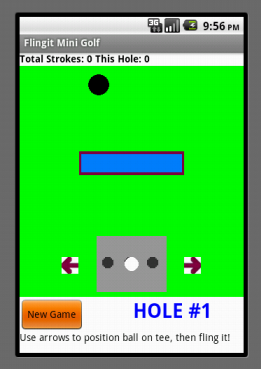
To play this mini golf app, the player first positions his/her ball within the confines of the tee, and then flings the ball toward the hole. The ball will bounce off of the rectangular obstacle and the sides of the course. For each fling of the ball, the stroke count goes up by one. The total score is the number of strokes it takes to complete the entire course.
This tutorial covers:
- Using the Sprite component and the TouchUp, TouchDown, and Flung events
- Using a Clock component
- Dynamic Positioning of sprites on a canvas, based on the size of the screen
- Sprite Collisions
This tutorial assumes you are familiar with the basics of App Inventor-- using the Component Designer to build a user interface, and using the Blocks Editor to specify the app's behavior. If you are not familiar with the basics, try stepping through some of the basic tutorials before continuing.

Part I: Start a new app and make a ball that responds to fling events
We'll build this app in stages, adding a little bit of the game at a time. Log into App Inventor and start a new project. Name it "MiniGolf". When the Design window opens notice that App Inventor automatically names the screen "Screen1", but you can set the Title of the screen, which will show up in the top bar of the app. Think of a title related to Mini Golf, or feel free to use the suggested title "Flingit Mini Golf", and type it into the Properties pane on the right side of the Designer.
In the Screen Properties (shown in right-hand pane): Uncheck the checkbox labeled "Scrollable" so that the screen will not scroll when the app is running. Screens that are set to scroll do not have a height. We’ll need our screen to have a defined height in order to set up the golf course properly.
Add the following components in the Designer:
Component Type |
Palette Group |
What You'll Name It |
Purpose |
Properties |
Canvas1 |
Basic |
Canvas1 |
The canvas serves as the golf course |
Height: 300 |
BallSprite |
Animation |
GolfBall |
This is the ball the player will fling to try to hit the Hole |
Radius = 10 Z = 2 (this makes the sprite appear on top of sprites with lower numbers) |
BallSprite |
Animation |
Hole |
This will be the target for the GolfBall |
Radius = 15 |
Clock1 |
Basic |
Clock1 |
The clock will fire continuously to control the movement of the ball |
Timer Always Fires Timer Enabled TimerInterval: 100 |
Open the Blocks Editor
Program the behavior of the Ball:
First, use the GolfBall.Flung event handler to move the golf ball when it is flung. Essentially, set the GolfBall sprite’s speed and heading to match the speed and heading of the player’s fling gesture. You may want to scale up the speed a little bit because the speed of the fling is a little slower than how a golf ball would move. You can play with this "scaling factor" to make the ball more or less responsive to a fling.
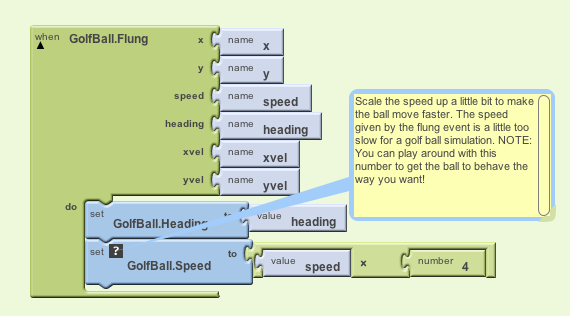
Program the behavior of the clock:
Use timer event to slow ball down so it doesn’t bounce around forever.
Each time the clock fires, it will reduce the speed of the ball slightly. Notice that if the ball is not moving then these blocks will do nothing. If you don’t have this then the ball will just bounce forever.
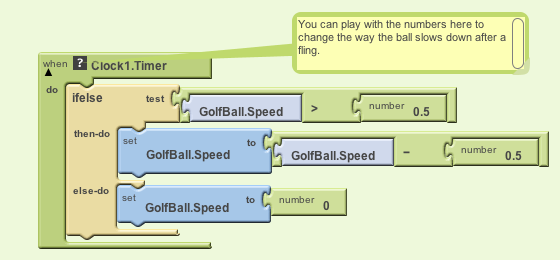
Program a new procedure called SetupNewHole:
This procedure will be called when a hole is scored and the ball has to be placed back at the starting point. Note that the Hole.MoveTo block sets the hole up in a new random location for the next play.
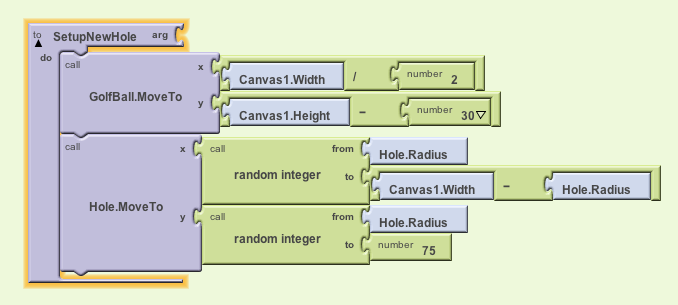
Program the Behavior of the Hole: When the ball collides with the hole, the ball disappears and resets at the bottom of the screen.
Note: When you first drag out the GolfBall.CollidedWith event handler, the named parameter is called "other". You can rename this by clicking once on the word "other" and typing in something new. Use a name that makes sense, as in this example where we use "ObjectHitByGolfBall". Notice that the if then block tests to see if the object involved in the collision with the golf ball (ObjectHitByGolfBall) is the black ball sprite representing the hole. You can't just put a text block with the word "Hole" in it, you must use the component Hole block, that can be found in the Hole drawer under "My Blocks". Do not use a text block here.
Does your ball get stuck if it hits the edge? This is easy to fix with the when EdgeReached event. Note that you can find the "edge" value block under My Definitions. You can also use a developer’s shortcut by clicking anywhere on the workspace background and typing the word "edge". You’ll see a dropdown box appear. If you click the word "edge" you’ll see the value edge block appear on the screen. Big time saver! Double check to make sure your code is right: fling the ball a few times and see that that ball now bounces off the edges of the course. Games are more fun if you have a way to see how you’re doing. Let’s add a stroke counter. In mini golf your score goes up as you take more strokes. The goal is to have the lowest score possible. Let’s show the player how many strokes she or he has taken on this hole. Let’s also show the number of strokes taken during the whole game. Go back to the Designer and set up the following components: Component Type Palette Group What You’ll Name It Purpose Properties Horizontal Arrangement Screen Arrangement HorizontalArrangement1 Contains LabelScore and LabelStroke Place at top of screen Label1 Basic LabelScore Displays the total stroke count for the entire game Label2 Basic LabelStroke Displays the stroke count for the hole the player is currently on In the Blocks Editor, you can program updates to the Score and Stroke labels. First, set two new global variables called StrokeCount and Score, and set their initial values to 0. Then add the following blocks to the GoflBall.Flung event (red rectangle indicates new blocks): Next add the following blocks to the Event that handles the ball hitting the hole: Ok, so now you’ve got a working game! Now let’s make it a little more interesting and fun. First we’ll add a Tee and let the player position the golf ball on the tee before they fling the ball. Go back to the Designer and add three new image sprite components: Component Type Palette Group What You’ll Name It Purpose Properties ImageSprite Animation Tee A rectangular area in which the player can position their ball before teeing off. Upload the Tee image (right click on this link, or see below). ImageSprite Animation LeftSprite This is a left pointing arrow that the player will use to move the ball to the left on the tee Upload the left arrow graphic (right click on this link ImageSprite Animation RightSprite This is a right pointing arrow that the player will use to move the ball to the left on the tee Upload the right arrow graphic (right click on this link Program the size of the canvas, and the placement of the ball and image sprites on the canvas: First, program the setup of these components on the screen. It’s best to accommodate all different screen sizes by placing the sprites on the screen relative to the size of the screen. The blocks below show how to set up the screen 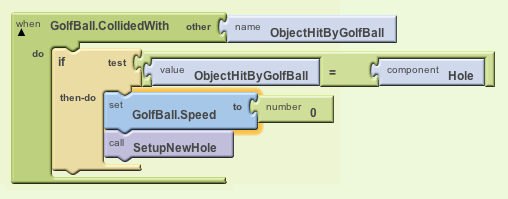
Test this Behavior. Connect your device to AppInventor, or start the emulator to load your app. When you fling the ball it should move in the direction of your fling, with a speed similar to the strength of your fling. The ball should slow down as it moves, eventually stopping. When the ball hits the hole, the ball should reset at the bottom of the screen and the hole should move to a new random location.

Part II: Keeping Score
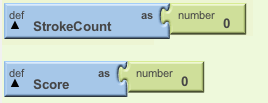
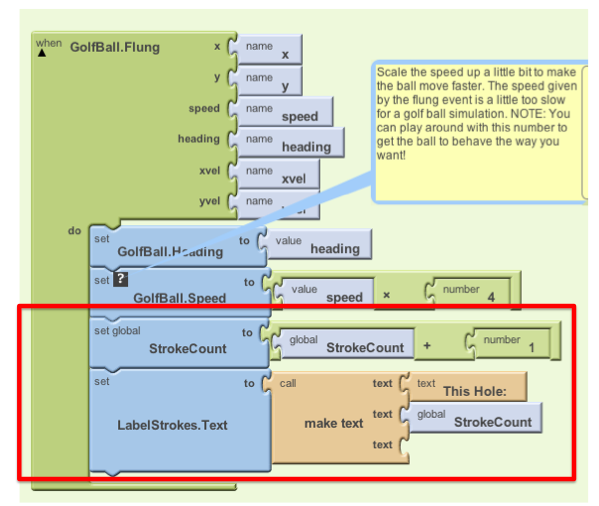

Test the behavior. With these new changes, you should have a "Total Strokes" count and "This Hole" count at the top of the screen. When you fling the ball, the "This Hole" count and "Total Strokes" count should both increase by one, and when you make the ball go into the hole the "This Hole" count should reset to 0.
Part III: Positioning Ball on Tee using TouchUp and TouchDown events

Position the Golf Ball on the Tee using TouchUp and TouchDown on the Arrow sprites:
To handle this, first set up two global variables that are toggled each time an arrow is pressed.

Program the behavior of the Right and Left Arrows
The left and right arrows are image sprites, so they come equipped with the ability to know when the player is is holding his/her finger down on them. The following blocks toggle the global variables based on whether the user is pressing either of these arrows.
![]()
Procedure MoveBallOnTee:
Make a new procedure MoveBallOnTee that makes the golf ball move left or right on the tee depending on the global variables. Although the math here looks complicated, it’s pretty simple. If the ball is supposed to move left, you first check to make sure that moving the ball 2 pixels left will not exceed the left-most coordinate of the Tee. If moving the golf ball to the right, you first check that moving the ball right 2 pixels will not move it past the right-most coordinate of the Tee.
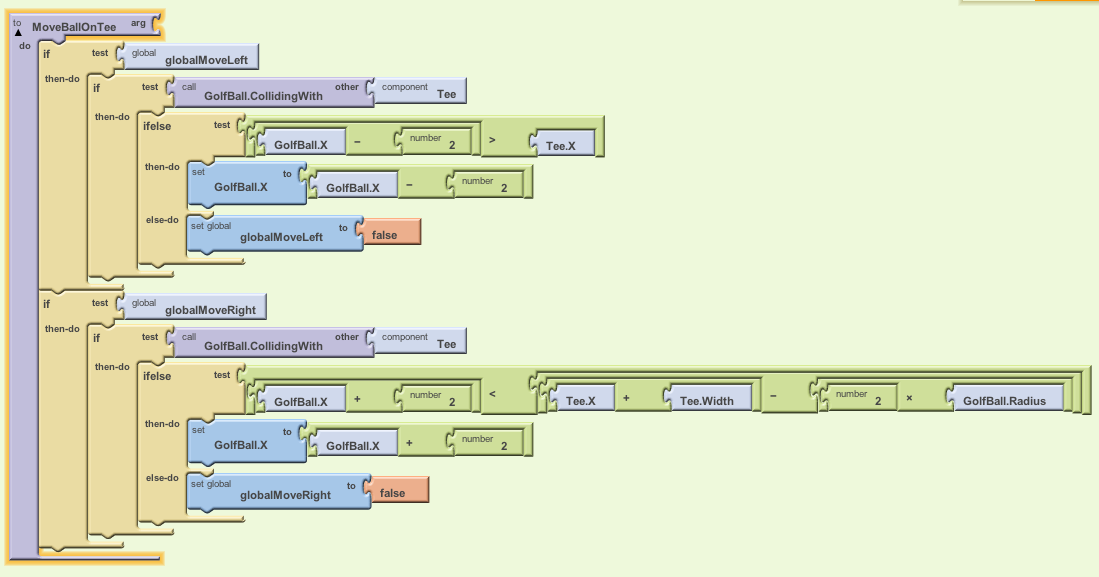
On each new course, players can position the ball on the tee before attempting to fling the ball toward the hole. To program this, you first have to check to make sure this is a new course and the ball has not been flung yet. If StrokeCount = 0 then we know this course is brand new and the player has not yet attempted to get the ball into the hole.

As the blocks above show, after verifying that the StrokeCount is 0, you then want to proceed to move the golf ball left or right depending on which arrow is being pressed.
Note that the blocks that we had inside the Clock1.Timer event are now moved over to a new procedure called MoveBallOnCourse:
MoveBallOnCourse Procedure
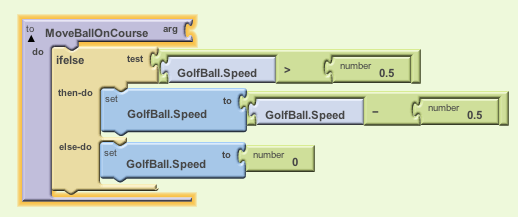
Test the behavior. Make sure your app is doing what you expect: play the game on your device or emulator. Before you tee off, are you able to move the ball left and right on the tee by using the left and right arrows? After you tee off, you should no longer be able to use the left and right arrows (pressing them will do nothing). After the ball goes into the hole and the screen resets, you should then be able to move the ball left and right on the tee before teeing off again.
Keep track of the number of holes played, and allow a game reset
The game is working pretty well now, but what about giving the player a way to reset the game? Also, it would be nice to give the player some instructions so they know how to play the game. While we’re at it, let’s also give an indication of how many holes the player has completed. Add the following components in the Designer:
Component Type |
Palette Group |
What You’ll Name It |
Purpose |
Properties |
Horizontal Arrangement2 |
Screen Arrangement |
Horizontal Arrangement2 |
Contains the NewGame button and the HoleNum label |
|
Button |
Basic |
ButtonNewGame |
Resets the game to Hole #1 with a score of 0. |
Text: "New Game" |
Label3 |
Basic |
LabelHoleNum |
Displays the current hole number, increments by one each time a hole is completed. |
Text = "Hole # 1" |
Label4 |
Basic |
LabelInstruct |
Displays instructions |
Text = "Use arrows to position ball on tee. Hit the ball by flinging it with your finger." |
Define a new global variable to keep track of the Hole Number:
![]()
Add the following blocks to the SetupNewHole procedure: set global HoleCount and set LabelHoleNum.Text...

Program the "New Game" button’s behavior, which is pretty simple. When the button is pressed, set up a new course and reset both the hole stroke counter and total stroke counter to zero. Also set the hole number back to 1, by displaying "Hole #1" in LabelHoleNum. The blocks look like this:

Test the behavior.Go back to your device or emulator and play the game some more. Now you should see the Hole # displayed in the lower right. Hitting "New Game" button should reset the game, returning both scores to 0, resetting the screen, and setting the Hole number to #1.
Part IV: Introduce an Obstacle
Most mini golf courses have obstacles on them. Let’s add a simple rectangular obstacle that will randomly position itself on the course somewhere between the Tee and the Hole. Each time a new course is presented, the obstacle will move, just the same way the Hole moves each time a new course is set up.
Add the following component in the Designer:
Component Type |
Palette Group |
What You’ll Name It |
Purpose |
Properties |
ImageSprite |
Animation |
ObstacleSprite1 |
This sprite will be somewhere between the golf ball and hole and will make it harder to get the ball into the hole |
Upload the obstacle (rectangle) graphic (right click on this link, or see below). |
Program the behavior of the obstacle in the blocks editor. First, set the behavior for when the ball hits the obstacle. *Note: Using Heading = 0 - heading works because we are dealing with bouncing off of horizonal surfaces, this will not work for bouncing off of vertical or inclined surfaces. For our purposes, it works all right. See Challenge #2 below for more information.
![]()
Each time the course is reset, position the obstacle will be positioned randomly. Add these blocks to the SetupNewHole procedure:
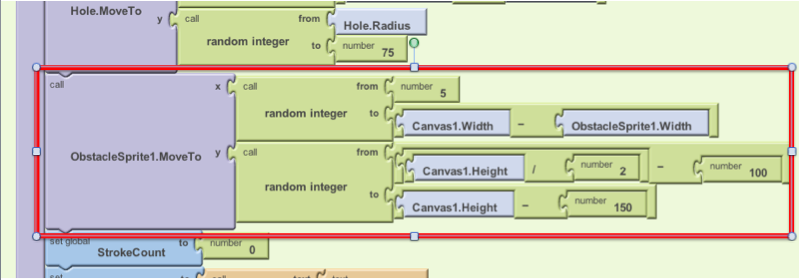
Test the behavior. Play the game again. Notice that the ball bounces off when it hits the obstacle. When the ball goes into the hole, or when the New Game button is pressed, the obstacle appears in a new location somewhere between the tee and the hole.
That’s it! Share your game with friends by building an APK or by downloading the source and sharing the zip file with other App Inventors!
Part V: Challenges
Here are some extra challenges to make your game better.
Challenge 1: Program the Ball to Hole collision so that the ball only goes into the hole if the golf ball’s speed is not too fast. In real mini golf, the ball will bounce right over the hole if you hit the ball too hard.
Challenge 2: There is a slight bug when the ball hits the vertical sides of obstacle. Figure out how to program the ball to obstacle collision so that it bounces the way you would expect when the ball hits the vertical sides.
Challenge 3: Limit the number of holes per game. Keep track of the number of holes and end the game after a set number. (A typical mini golf course has 18 holes.)
Below is a summary of all of the components, and a screen shot of all the blocks (some are collapsed to save space.)

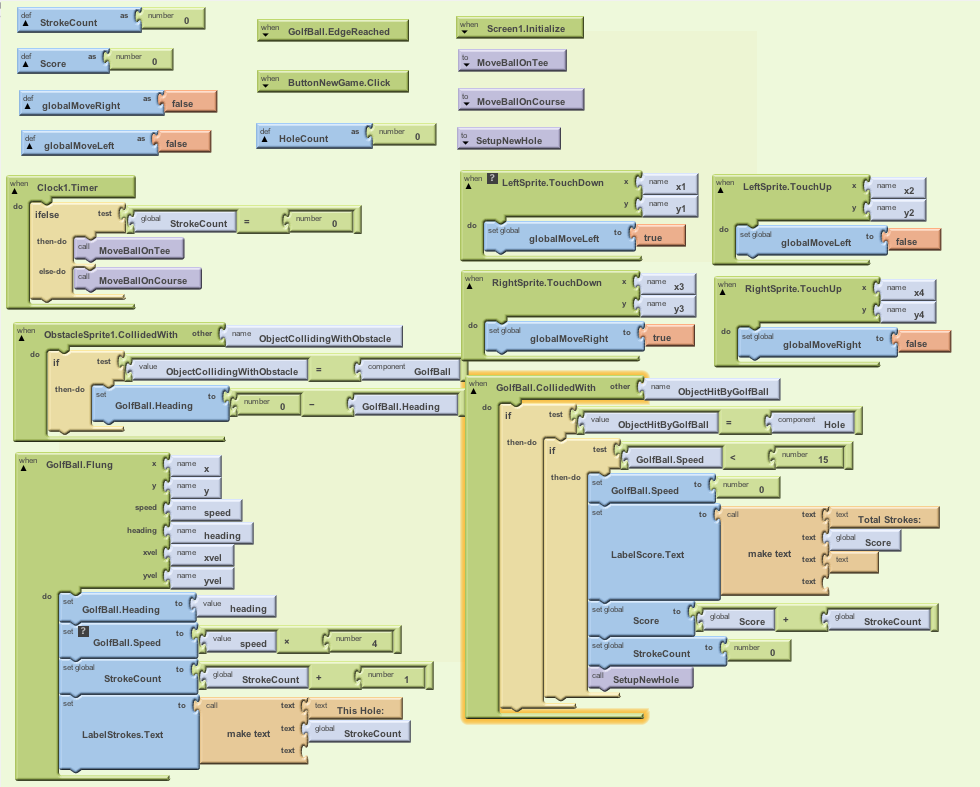
Scan the following barcode onto your phone to install and run the sample app.
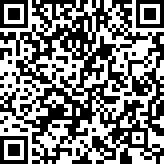
Download Source Code
If you'd like to work with this sample in App Inventor, download the source code to your computer, then open App Inventor, go to the My Projects page, and choose More Actions | Upload Source.
Done with Mini Golf? Return to the other tutorials.







